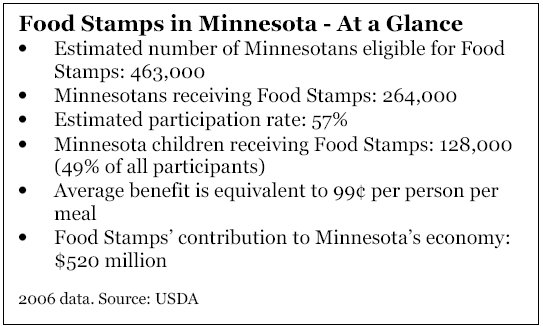Food Stamps: The Nation’s Most Successful Anti-Hunger Initiative
In the late 1960s, medical studies revealed that American children were dying from diseases related to severe malnutrition. Food Stamps were made available nationwide, and in 1979, doctors found that severe malnutrition had become rare, a result they attributed to Food Stamps.

Today, Food Stamp coupon books have been replaced with a debit-like electronic bank transfer card that can only be used to purchase food, but the core mission of Food Stamps has remained constant: to prevent malnutrition and hunger. Currently, 26 million low-income seniors, children, working families, people with disabilities and other Americans use Food Stamps every month.[1]
Food Stamps Provide Critical Support to Minnesota’s Families and the Economy
Food Stamps serve an important public health function by preventing costly health problems associated with hunger and malnutrition. Almost one in five children live in families that use Food Stamps to afford an adequate diet. Malnutrition can be especially damaging to the mental and physical development of young children, which in turn harms their ability to succeed in school and later in life. Studies show that children who live in “food insecure” households — those who have difficulty affording food — are almost twice as likely to be in poor health as other children, since inadequate nutrition can harm a child’s immune system and heighten the likelihood of contracting diseases.[2]
One in 20 Minnesotans is helped by Food Stamps. Of the total amount of Food Stamps spent in Minnesota, 77 percent are used by families with children. Most of the remainder goes to elderly people or people with disabilities. The typical Minnesota family with children using Food Stamps has an annual income (not including Food Stamps) at just 41 percent of the federal poverty line, or $6,809 for a family of three.
In recent years, the increased cost of necessities like utilities, housing and health care, combined with stagnant wages and a weak economy, have increased the need for Food Stamps. From 2000 to 2006, the number of Minnesotans using Food Stamps increased 35 percent.
Food Stamps also make an important contribution to Minnesota’s economy. In 2006, $282 million in Food Stamps was spent in Minnesota, benefiting local farmers and grocers. But the USDA estimates that every dollar of Food Stamps generates almost two times that amount in total economic activity.[3] This means that Food Stamps have a $520 million impact on Minnesota’s economy.
Value of Food Stamps Eroding
The average amount of Food Stamps in Minnesota is the equivalent to 99 cents per person per meal. While this modest amount is a critical support for financially pressed families, families often run out of Food Stamps before the end of the month. The value is also too low for families to afford healthier foods like fresh fruits and vegetables.
For most families, the value of Food Stamps does not keep up with inflation. In Minnesota, 80 percent of households see their Food Stamps’ purchasing power diminish every year, due to cuts enacted in 1996. This means that in 2008, 214,000 Minnesotans will receive $28 million less in Food Stamps compared to what they would have received if the value had not been frozen for 11 years. This is the equivalent of $24 a month in groceries for a typical working family of three. Over the next decade, the cumulative impact is a loss of $376 million in Food Stamps, and a loss to the Minnesota economy of almost $700 million.
While Food Stamps have been successful in lessening hunger and malnutrition, nonetheless Food Stamps only reach an estimated 57 percent of all eligible households in Minnesota. Many hungry families miss out because they didn’t know that help was available, or because of complicated rules that make it difficult to sign up.[4]
Congress Must Renew its Commitment to Fight Hunger and Malnutrition
In 2007, Congress will reauthorize Food Stamps as part of the Farm Bill. The Bush Administration has proposed several positive changes that would somewhat broaden the reach of Food Stamps, including exempting all retirement accounts from strict asset limits and allowing deduction of the full amount of child care costs in the calculation that determines the value of Food Stamps the family will receive.
However, these proposed improvements to Food Stamps are far outweighed by a proposed $740 million cut to Food Stamps over the next five years. Under the Administration’s proposal, over 300,000 Americans — primarily in low-income working families — would lose access to Food Stamps by 2010.[5] Minnesota would be disproportionately impacted by this proposal, due to the way the state determines Food Stamp eligibility.
Now more than ever, Food Stamps are an important support for working families in Minnesota and a boost to the state economy. As it crafts its 2007 Farm Bill, Congress should strengthen Food Stamps in the following ways:
- Stop the erosion of Food Stamps’ purchasing power: Food Stamps should retain their purchasing power over time. Continuing to ignore the impact of inflation means that millions of Americans are less able to feed their families each year. Congress should reinstate its policy of indexing Food Stamps to inflation.
- Reduce obstacles to participation: Despite recent improvements, too many eligible households are missing out on the vital assistance that Food Stamps provides in preventing hunger and promoting nutrition. Congress and Minnesota should work to reduce unnecessary paperwork, streamline eligibility rules where appropriate, and invest in outreach and enrollment efforts.
[1] Except where otherwise noted, information comes from the United States Department of Agriculture, Food and Nutrition Service.
[2] Children’s Sentinel Nutrition Assessment Program, Food Stamps as Medicine: A New Perspective on Children’s Health.
[3] For more infomation on the USDA multiplier calculation, see Supplemental Nutrition Assistance Program (SNAP).
[4] For more on this issue, see Legal Services Advocacy Project, 1 Simple Task: Enroll More Eligible Families & Seniors in Minnesota’s Food Support Program.
[5] Center on Budget and Policy Priorities, Administration Proposal Would Cut Over 300,000 People Off Food Stamps.